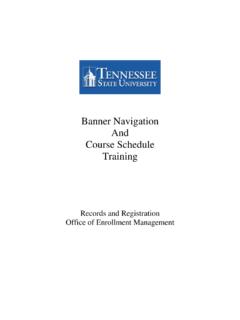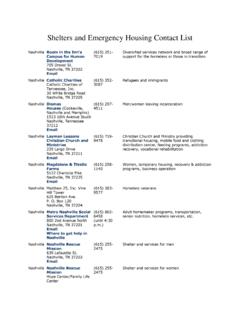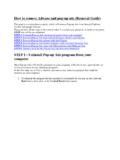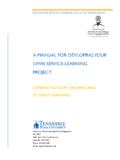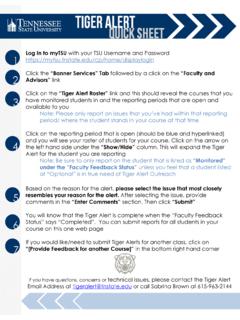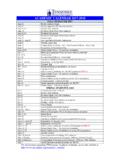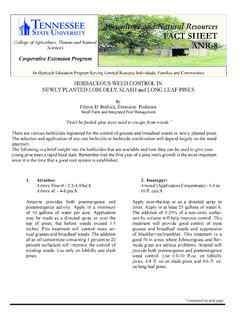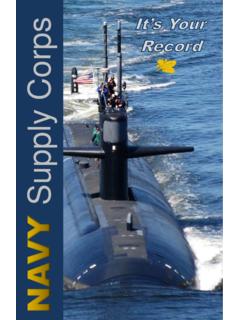Transcription of ASSESSMENT AND IMPROVEMENT PLANNING guide
1 ASSESSMENT AND IMPROVEMENT PLANNING IN COMPLIANCE ASSIST! A. Overview The Compliance Assist! (CA!) system is the heart of Tennessee State University s ASSESSMENT documentation system. In it units provide their PLANNING narratives and track the progress on measurable outcomes in the areas of performance and student learning designed to achieve the PLANNING goals. The organizational structure in CA! is a hierarchy of levels that follows the format of Level 0. Institution Level 1. Division ( , Academic Affairs, Business and Finance) Level 2. Unit (Colleges, Schools, Offices, , College of Business, School of Graduate Studies, Finance and Accounting) Level 3. Sub-unit (Departments) Level 4. Program ( , Psychology, English ) Here is a snapshot from CA!
2 Expanded to show programs in the Department of Teaching and Learning, College of Education, Academic Affairs. With the Levels indicated. Figure 1. 2 ASSESSMENT AND IMPROVEMENT PLANNING guide The Organizational Coding System is based on this schema using codes for levels 1 3. For the example above, the code designation is Unit Code-Key Code-SubUnit Code: ACA 304 103. Using consistent coding where required greatly facilitates generating meaningful reports in CA!. B. Log in To start using Compliance Assist! You will need to point your browser to This takes you to the Authentication or Log In screen shown in Figure 2. Figure 2. The User Name will be your full TSU email address in the form of where yname is your tnstate username. The Password is the one assigned to you for CA!
3 And is not necessarily the same as the one used to access the TSU system. Click the Log In button or just press the enter/return key on your keyboard and you ll be taken to the CA! Home screen. If you don t have a username and password for CA!, please contact the Office of Institutional PLANNING and ASSESSMENT at 615-963-2551. C. Home Screen This is the Home screen in CA!: ASSESSMENT AND IMPROVEMENT PLANNING guide 3 Figure 3. This screen contains announcements and the welcome message. Only two lines of the full message show on the screen. To get to the rest, you click on More > >. Expanding the Resources and Instructions 2011-2012 will take you to links for (1) Quality IMPROVEMENT , (2) New Organizational Coding System, and (3) Relating outcomes to Mission and Strategic Plan which are described in the next section D.
4 Resources and Instructions 2011 2012 When you click on More >> under Resources and Instructions 2011 2012 or on the title you ll get the screen shown in Figure 4. Figure 4. For the purposes of this guide we will only need (2) New Organizational Coding System. The chart shows the coding you will use to identify outcomes for your unit. As explained above in the Overview, Codes have been assigned to each level below Institution which is Level 0. Every Division (Level 1) has been given a three 4 ASSESSMENT AND IMPROVEMENT PLANNING guide character code. For example Academic Affairs has the Division code ACA. The next level (Level 2) has been designated a Unit and given a three-digit numeric Key code. Units are colleges, schools and in the non-academic areas, offices.
5 The College of Liberal Arts is 302, Business 303, Education 304, etc. Sub-unit codes have been assigned to all entities at Level 3 and are typically in the 100s. Here are a couple of examples of the Combo Codes : Example 2. Languages, Literature, and Philosophy<College of Liberal Arts<Academic Affairs = ACA 302 105. Example 3. Human Resources<Business & Finance = BUS 401. As long as the codes are consistent and follow the chart, any separator may be used. The following would all be equivalent in CA!: underscore ACA_302_105, hyphen ACA-302-105, or space ACA 302 105. What is important for reporting purposes that some separator is used between each part of the Combo Code. E. Institution Tab Your workspaces in CA! will be found by clicking the | Institution | tab in the strip below the blue PLANNING banner from any screen as shown in Figure 5.
6 Figure 5. Clicking on | Institution | will take you to the Institution screen area. You will land on the ASSESSMENT & IMPROVEMENT Plan (A&IP) screen as shown in Figure 6 since it is the first tab under Institution. ASSESSMENT AND IMPROVEMENT PLANNING guide 5 Figure 6. Take a minute to familiarize yourself with the layout of the Institution screen. You ll see new tabs in the white area. In Figure 6 you see that you are in the ASSESSMENT & IMPROVEMENT Plan tab which is where you ll be doing your entry related to outcomes in CA!. The other tab you may need to use is to the right of this one and is labeled Strategic Plan 2010-2015. You ll learn more about that in the next section. Notice that the main screen is divided into two sections. On the left is the Navigation pane that allows you to move through the organizational chart to your specific area of responsibility.
7 The [ + ] button indicates that there are sub-levels below the entry. Clicking the button expands to show the next level down and the button changes to [ - ]. Clicking by Academic Affairs, for instance, show a new column of units under Academic Affairs. Most of these can also be further expanded to find sub-units such as departments. Figure 7 shows the Navigation pane expanded to the program level for the General Education Literacy in the Department of Languages, Literature, and Philosophy which in the College of Liberal Arts under Academic Affairs. In the right hand window you see the four Student Learning Outcomes (SLOs) for this program. This is the level where most of your work will be done: relating current Performance Outcomes (POs) and SLOs to the university mission and the College or non-academic subunit s strategic plan and/or creating and relating new ones to support the 2010 2015 plan.
8 6 ASSESSMENT AND IMPROVEMENT PLANNING guide Figure 7. Before looking at that process in more detail, you first need to know what your unit s Strategic Plan says. For that we will go to the | Strategic Plan 2010 2015 | tab in the Institution area of Compliance Assist!. F. Strategic Plan 2010 2015 As an example of what you will see on the Strategic Plan side of things, Figure 8 shows you a view of the Strategic Plan 2010 2015 for the College of Education. For the most part, only units at this level and above will have PLANNING narratives. Figure 8. ASSESSMENT AND IMPROVEMENT PLANNING guide 7 The university s strategic plan is divided into five areas which we call Key Performance Indicators or KPIs: 1. Access and Diversity 2. Academic Quality and Student Achievement 3.
9 Business Friendly Practices 4. Revenue Generation/Research/Resourcefulness 5. Engagement Links have also been provided at each unit level to the parts of the University Mission statement: Tennessee State University, an Historically Black College/University (HBCU), fosters scholarly inquiry and research, lifelong learning, and a commitment to service. A. Scholarly inquiry [Instruction] includes those initiatives at the University that are focused primarily on teaching and educating students. B. Research includes those initiatives at the University that are focused primarily on generating new knowledge or expanding existing knowledge. Initiatives in this category generally result in a publishable product, including those that are submitted for publication and those that are actually published.
10 This also includes research work presented at professional meetings/conferences. Also included in this category are those initiatives that result in creative products and productions. C. Lifelong learning includes those initiatives at the University that promote, support, or help to develop the skills and commitment of students, faculty, staff, and the community to continue their intellectual and personal growth. D. Service includes those initiatives at the University that are focused primarily on applying the expertise, skills, and knowledge of students, faculty and other employees for the betterment of the University s external and internal constituent communities Figure 8 shows the five KPI narratives for the College of Education as well as the four parts of the University Mission.
